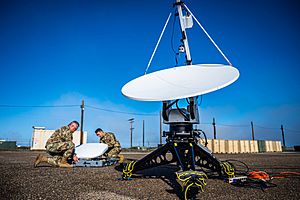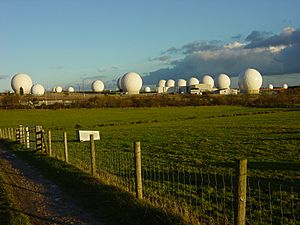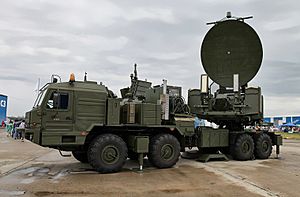Electromagnetic warfare facts for kids

Electromagnetic warfare (also called electronic warfare or EW) is a type of warfare that uses invisible energy waves, like radio waves or light. It's all about controlling these waves to help your own side and stop the enemy from using them. Think of it like a silent, invisible battle where signals are the weapons.
The main goal of electromagnetic warfare is to make sure your side can use the electromagnetic spectrum (all the different types of energy waves) without problems, while making it hard for the enemy to use it. This kind of warfare can happen from planes, ships, land, or even space. It can target things like communication systems, radar, or other military and even civilian equipment.
Contents
Understanding the Electromagnetic Environment
Modern military operations happen in a world full of information, and a big part of that is the electromagnetic spectrum. This part of the information world is called the electromagnetic environment (EME). It's super important for military forces to be able to use this environment freely. This need creates both challenges and chances for electronic warfare to help military operations.
NATO, a group of countries working together, sees the EME as a battlefield, just like land, sea, or air. In NATO, electronic warfare is seen as fighting within this electromagnetic environment. They use simple terms:
- Electronic Attack (EA) is using electromagnetic energy to attack.
- Electronic Defense (ED) is protecting against such attacks.
- Electronic Surveillance (ES) is watching and listening to enemy signals.
Other activities in this area include gathering intelligence, watching (surveillance), finding targets, and reconnaissance (scouting). Over time, EW activities have grown to use the special properties of electromagnetic energy. These activities include using countermeasures against light, infrared (heat), and radio frequency signals. They also involve radio jamming, radar jamming and deception, and ways to stop jamming (anti-jamming).
Main Parts of Electronic Warfare
Electronic warfare has three main parts:
- Electronic Attack (EA)
- Electronic Protection (EP)
- Electronic Warfare Support (ES)
Electronic Attack: Disrupting the Enemy
Electronic attack (EA) is about using electromagnetic energy, special energy weapons, or anti-radiation weapons to harm enemy people, buildings, or equipment. The goal is to weaken, stop, or destroy the enemy's ability to fight.
Often, this means "jamming" enemy communications or radar systems. Jamming is like sending out so much noise on a radio frequency that the enemy can't hear their own signals. Anti-radiation weapons are often missiles or bombs that can find a specific signal (like a radio or radar signal) and follow it directly to destroy the system sending that signal.
Electronic Protection: Staying Safe

Electronic protection (EP) is about defending against an enemy's electronic attack. It also protects against friendly forces who might accidentally cause electronic interference (sometimes called EW fratricide). The better the EP, the better it can stop an electronic attack.
For example, flares are often used by planes to trick infrared homing missiles that track heat. The missile's system might have "flare rejection logic" to ignore the flares, which is an example of EP. While both jamming (EA) and EP help protect, EP specifically protects from the effects of electronic attacks. Other examples of EP include using special radio technologies that spread signals out (making them harder to jam) and stealth technology that makes vehicles hard to detect.
Electronic warfare self-protection (EWSP) refers to systems on aircraft that protect them from weapons. These can include:
- Directional infrared countermeasures (DIRCM) and flares to protect against infrared missiles.
- Chaff (radar countermeasure)|Chaff (tiny pieces of material) to protect against radar-guided missiles.
- DRFM decoy systems to protect against radar-targeted anti-aircraft weapons.
There are also special training areas called electronic warfare tactics ranges (EWTRs). These ranges have ground equipment that can pretend to be enemy electronic threats, helping pilots and other military personnel practice how to deal with them.
Electronic Warfare Support: Gathering Information

Electronic warfare support (ES) is about detecting, intercepting, identifying, locating, and finding the source of both intended and unintended electromagnetic energy. These Electronic Support Measures (ESM) help military commanders quickly recognize threats. This is often called reconnaissance, or more commonly, ISTAR (Intelligence, Surveillance, Target Acquisition, and Reconnaissance). The main goal is to give battlefield commanders quick information to recognize, prioritize, and target threats.
Signals intelligence (SIGINT) is a related field. It involves analyzing and identifying intercepted signals from things like radio communication, mobile phones, radar, or microwave communication. SIGINT is divided into two types:
- Electronic intelligence (ELINT)
- Communications intelligence (COMINT)
The difference between SIGINT and ES depends on who is collecting the information and what it's used for. ES is done by forces under a commander's control to provide tactical information, like finding and avoiding threats. However, the same equipment used for ES can also collect information for broader, more strategic intelligence.
A Brief History of Electronic Warfare
Electronic warfare has been around for over a hundred years. One of the earliest examples was during the Russo-Japanese War in 1904–1905. A Japanese ship found the Russian fleet and was sending its location by "wireless" (early radio). A Russian warship captain wanted to jam the Japanese signal, but his admiral said no. The information the Japanese got helped them win a huge battle, which ended the war.
During World War II, both the Allies and Axis Powers used EW a lot. This was sometimes called the "Battle of the Beams" by Winston Churchill. Navigational radars were used to guide bombers. The first use of EW in WWII was to defeat these radars. Chaff was also invented during WWII to confuse radar systems.
As technology improved, so did electronic warfare. It played a big role in the Vietnam War. Planes often relied on EW to survive, though many were still shot down.
In 2007, during Operation Outside the Box, Israel reportedly used electronic warfare to disable Syrian air defenses. This allowed Israeli jets to fly across Syria, bomb a suspected nuclear site, and return without being stopped. Some reports say Israeli EW systems turned off all of Syria's air defense systems for the entire time of the raid.
More recently, in December 2010, the Russian army received a new land-based EW system called Borisoglebsk 2. This system combines four different jamming stations into one, helping operators make quick decisions. It's designed to jam satellite communications and navigation signals. Its early use caused concern among NATO countries.
During the start of the 2022 Russian invasion of Ukraine, Russian EW disrupted Ukraine's air defense radars and communications. This made Ukrainian ground-based air defense systems much less effective. However, the Russian jamming also interfered with their own communications, so they reduced their efforts. This allowed Ukrainian air defenses to become more effective again. By late March and April, Russia had set up many EW systems in the Donbas region. Their electronic jamming of GPS and radio signals caused Ukraine to lose many UAVs (drones), which meant less intelligence and less accurate artillery fire. By summer 2022, only about one-third of Ukrainian drone missions were successful, and EW was a big reason Ukraine lost 90% of its thousands of drones.
Russian EW also reduced the success of Ukrainian HIMARS rockets and JDAM bombs. By jamming GPS signals, these weapons had to use a less accurate navigation system, making them less precise. In May 2023, a report said Ukraine was losing about 10,000 drones a month due to Russian electronic warfare, which is about 300 drones a day. Russia has EW posts every few miles along the front lines.
See also
 In Spanish: Guerra electrónica para niños
In Spanish: Guerra electrónica para niños
- Cyberwarfare
- Electromagnetic pulse
- Electromagnetic interference
- Suppression of Enemy Air Defenses (SEAD)
Other electronic warfare systems:
- ADM-160 MALD
- Krasukha (electronic warfare system)
- Radar warning receiver (RWR)
- Samyukta electronic warfare system
- Sky Shadow (radar)
Historic:
- Battle of Latakia: the first known use of deception EW in a naval battle.
- No. 100 Group RAF


